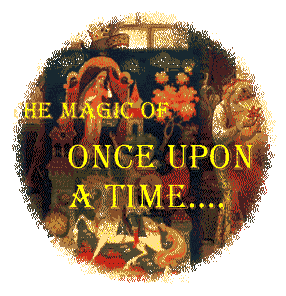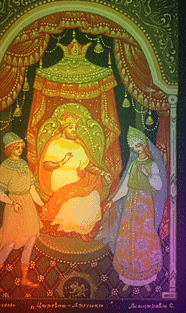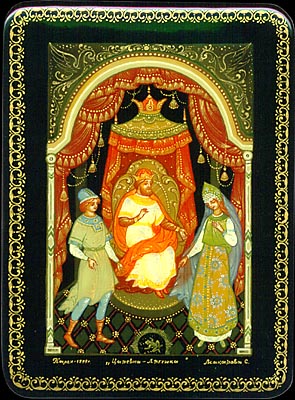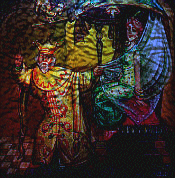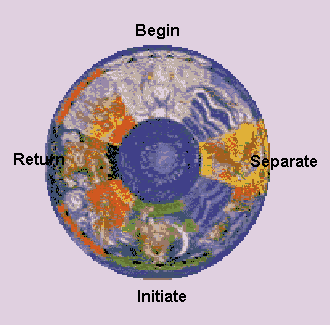|
Narrative Logo - Click for Main Menu One Religion all Religions
Joseph Campbell and the Hero With a Thousand Faces
Caption: Russian Folktale Illustration I am indebted, again to Kathleen Jenk's site, MYTHING
LINKS for images and links to the sites listed on this page--
Caption: Russian Folk Tale Illustration transformed to rainbow colors so I have taken it upon myself to transform these images In Hero, Campbell argues (much like Propp) that no matter where we look, and he says from the "dreamlike mumbo jumbo of some red-eyed witch doctor of the Congo...the mystic Lao-tse...the arguments of Aquinas...or a bizarre Eskimo fairy tale" -- we can find "a shape-shifting yet constant story." He maintains that, from the simplest nursery rhyme to full-blown foundation legends, the mythic elements are "spontaneous productions of the psyche, and each bears within it, undamaged, the germ power of the source." So our question would be, What is the Source? One small problem with this for women, perhaps, is that the source for Propp is the Quest motif, and that is very hard for women to participate in (and for us to imagine as the only universal theme, because for so many centuries in the stories, the women stayed close to home - they go to the palace only when invited, and most of the time they venture no further than the marketplace.)
Russian Folk Tale Illustration
Joseph Campbell makes a similar gender-excluding move by claiming that the Hero Cycle is ultimately based on the life cycle. But he generalized the life cycle of men to all people, thereby excluding women in some profound way from the human experience. If the basis of all tales is the Freudian conflict between mother-love and father-hate, the infant stage of men in particular, then we have no parallel cited that covers and explains female experience. But what can we do? The women are not, in Campbell's universe, actually being asked to grow up - something that Campbell sees as the primary function of the mythic urge. Campbell sees the Hero as the man who has cycled through to Submission and is therefore ready to participate in Rebirth. [Again, are we to assume that woman is born submissive, and therefore has no need to learn submission?] When the Hero finishes his journey, he is prepared to give birth to the new which is always a symbolic regeneration of the old. And this, Campbell maintains, is the center pivot of all the questing.
Caption: Wanderer in the Labyrinth "Peace is a snare; war is a snare; change is a snare; permanence is a snare. When our day is come for the victory of death, death closes in; there is nothing we can do, except be crucified--and resurrected; dismembered totally, and then reborn." Already you can spot in the Campbell theories the echo of Osiris, Gilgamesh, Jesus, Dante, and, of course, King Arthur. But Campbell goes further to insist that ALL of the stories we have read (jeez, except the ones about women) - have this same pattern. He makes this work by a clever act that is a transformation in itself, the abstracting of all events into one event. For example, he says: "The happy ending of the fairy tale, the myth, and the divine comedy of the soul, is to be read, not as contradiction, but as a transcendence of the universal tragedy of man."
Caption: The Tarot card of Fate "It is the business of mythology proper, and of the fairy tale, to reveal the specific dangers and techniques of the dark interior way from tragedy to comedy. Hence, the incidents are fantastic and 'unreal': they represent psychological, not physical triumphs." So, in order to map this process, Campbell uses a formula he finds represented in rites of passage throughout the world. He identifies these as separation--initiation--return, and he visualizes these as points on a circle. He terms this the nuclear unit of the monomyth [notice the fact that this leaving home is the nucleus of the only myth. Hummm]
Caption: Diagram of Campbell's Hero Cycle - Begin, Separate, Initiate, Return - chart by M. Luesebrink He sums the action up in this way: A hero ventures forth from the world of common day into a region of supernatural wonder: fabulous forces are there encountered and a decisive victory is won: the hero comes back from this mysterious adventure with the power to bestow boons on his fellow man." Campbell shows the pattern of this in every hero from Buddha to Moses to Hercules to Puss in Boots, I guess. But each of the stages, as with Propp, has a patterned set of motifs. Separation or Departure: 1. The Call to Adventure 2. Refusal of the Call 3. Supernatural Aid 4. The Crossing of the First Threshold 5. The Belly of the Whale.
Caption: Tarot Card - The Hanged Man Trials of initiation 1. The Road of Trials 2. The Meeting with the Goddess 3. Woman as Temptress 4. Atonement with the Father 5. Apotheosis 6. The Ultimate Boon
Caption: Russian Folk Tale Illustration
return and integration with society 1. Refusal of Return 2. The Magic Flight 3. Rescue from Without 4. The Crossing of the Return Threshold 5. Master of the Two Worlds 6. Freedom to Live
Caption: Russian Picture Box Campbell claims that whether the Hero is local or a savior of the world, whether the cycle takes place as a physical action or a moral journey, there is little variation from from morphological shape of the adventure. If one or another element is missing from the fairy tale, legend, ritual or myth, it is bound to be somehow or other implied. And so, our challenge is ahead. How does Sir Gawain and the Green Knight match up with Propp and Campbell? Or is this just too neat a box in which to put all of our folk stories?
|
